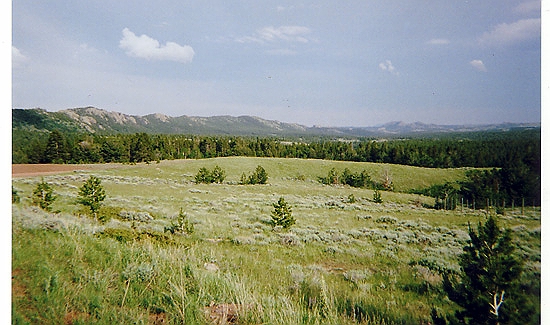
Happy Jack, 2005. Photo by Geoff Dobson
West of Cheyenne and east of Laramie along Middle Crow Creek is an isolated
area of two billion year old granite outcroppings, evergreen forest, and meadows known
to early explorers as "Skull Rocks." To later settlers it became known as
"Happy Jack" after early lumberman and hay cotractor Jesse S. "Happy Jack" Hollingsworth (1832-1909).
Hollingsworth received his nickname from his habit of singing while he worked. Happy Jack was
originally from North Carolina. By age 21, he was a bullwhacker for Steele, McCord & Co. which between
1850 and 1857 was engaged in
trailing cattle, mules and other livestock from St. Joseph, Missouri, to Sacramento where the animals would
be sold at a high profit. After one such journey, he ramained in California. He subsequently prospected in
Lassen County, California, the British possessions, and Idaho. About 1865, he trailed a herd of horses from
Oregon to Wyoming. In Wyoming, he became a
hay and wood contractor for the Army. With the Black Hills gold rush, he returned to prospecting at
Deadwood and Custer City. In 1879, he moved to Colorado at first ranching and later growing apples.
In the late 1920's, the name "Vedauwoo" began to be
applied to the area, the name taken from the
central character of a play written by a University of Wyoming drama professor who took the name from
the Arapahoe word bi-ito'o'wu meaning "earthborn".
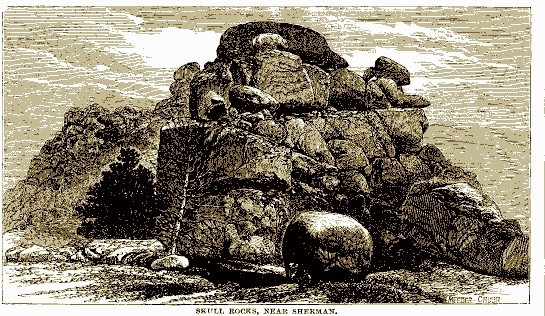
Skull Rocks, woodcut
The area constitutes a
divide from which many of the historic waterways of Wyoming flow: Horse
Creek, Lodgepole Creek, and Lone Tree Creek. Fron the area also flow North
Crow Creek, Middle Crow Creek, the North Branch of South Crow Creek and the South Branch of South
Crow Creek, all of which combine into a stream which provided water for the great Army vittling yard at
Camp Carlin, for Fort D. A. Russell, and along which John Wesley Iliff watered his cattle.
With the construction of the railroad, tie hacks ventured into the area.
After the tie hacks left, a few intrepid souls settled in the early 1870's. With the
water from the creeks, the area was ideal for the grazing of cattle. Even
today in the upper regions of Happy Jack, cattle
will be found on the open range of the meadows.
Among those who ventured into the Upper Crow to establish small ranches and farms were a former divinity student William Ferguson and his wife
Martha. They came to the area with their two daughters Clara and Eva. Soon two sons were born, William and
Walter. Conditions were harsh. Another son died and in the cold of winter proper burial had to await spring thaw. Others came to Upper Crow Creek:
Frank Kibler who ran a saw mill; rancher Anan Simmons; Thomas Holt from Freo County, Texas; Hugh J. Edwards, originally from Wales; and George Shelton, a teamster.
By 1880, some 69 settlers were living in the area.
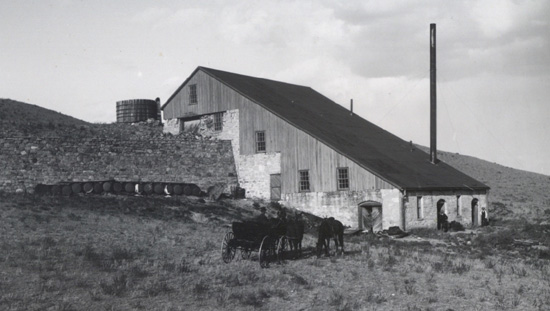
Stamping Mill, Hecla, Wyoming,
photo by J. E. Stimson. Photo courtesy the Laramie County, Wyoming,
William and Martha Ferguson Clan Historical Archives (the "Ferguson Archives").
Following the Civil War, a need for copper developed.
During the period Between 1867 and 1884, the Calumet & Hecla Mining Company of Michigan produced half of the country's copper.
Between 1889 and 1900, the Company paid out $57 million in dividends. Thus, there developed a copper rush to
areas in which copper deposits might be found. One of those areas was Happy Jack. In 1879, with the discover of copper and gold along Upper Crow Creek,
the Silver Crown Mining District was formed. Beginning in
the 1880's a series of mines opened in the District. Mines included the Hecla Mines, owned by the Hecla Copper &
Golf Mining, Milling & Smelting Co.; the Lenox; the Julia Lode;
the Agata Prospect, which produced gold; the
two Arizona Mines; the Barlett Copper King; the Fairview; the Great Standard Group owned by the Great Standard Copper Mining Co.; the Kopper Krown Mines; the London; and the
Louise.
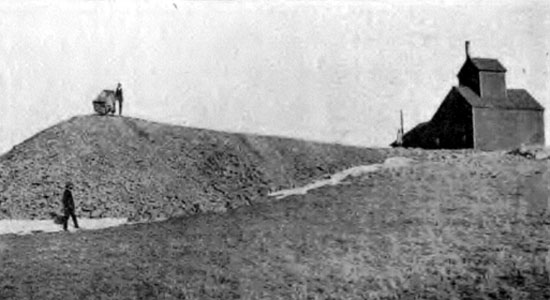
Tailing Dump, Strong Copper Mining Company, Upper Horse Creek, 1906.
The Strong Copper Mining Company was organized in 1903 and was capitalized at $1,000,000.
The mine used an 80 h.p. steam hoisting plant. By 1908, the mine
was idle.
William Ferguson opened the King David Mines (later known as the Comstocks) about 1 1/2 miles northwest of Hecla and established a smelter.
Most of the mines were centered on Granite Canyon or in an area along
Middle Crow Creek south of present day Happy Jack Road.
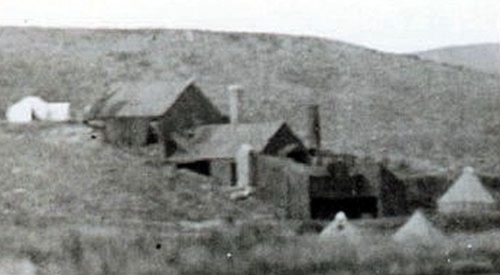
Smelter, Hecla, Wyoming, undated. Photo courtesy
Ferguson Archives.
The stamping mill was constructed by the Adams Copper
Mining and Reduction Co. It was later sold to the Hecla Copper & Gold Mining & Smelting Co.
The company owned some 14 claims, the townsite of Hecla, a millsite, a smelter, concentrating and leeching play, assay lab and office
building. In 1904, the company changed its name to the Hecla Mining Co. The company
subsequently changed its name again to the Hecla Consolidated Mines Co. Although, there may have been
some spectactular finds of native gold, on an average the ore in the area only assays at about 0.02 ounces
of gold per ton and the
copper at only 0.2%. The larger outside companies had financial difficulties. By 1906 The Great Standard Copper Mining Co. was
broke notwithstanding its touting of the discovery of platinum deposits.
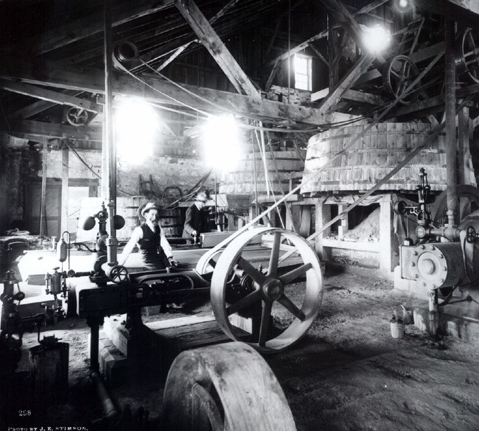
Interior Stamping Mill, Hecla, Wyoming, photo by J. E. Stimson, undated. Ferguson Archives.
The stamping mill was powered by a wood-fired steam engine. The pump-like device on top of the steam engine
to the right in the above photo is the governor.
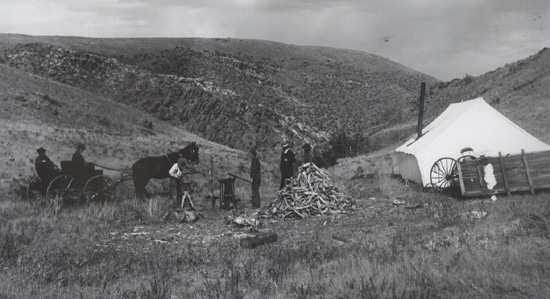
Wood camp for fuel for stamping mill, Hecla, Wyoming, photo by J. E. Stimson, undated. Ferguson Archives.
During Wyoming's copper boom, it was not uncommon for unscrupulous mining promotors to
promote their project by citing the sucess of others. Thus, Hecla most probably takes its name from
such an effort by mine promotors to bask in the reflected success of an
earlier copper mining project in Michagan developed by the Calumet & Hecla Mining Company.
There appears to be
no relationship between Calumet & Hecla of Michigan and the Hecla Copper & Gold Mining, Milling & Smelting Co., the developers of
mines within the Silver King Mining District. The name "Hecla" derives its name from a volcano in Iceland, Hekla.
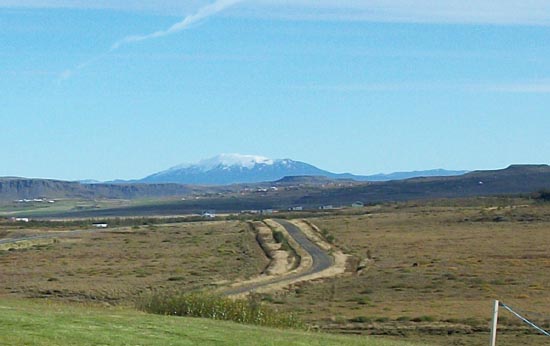
Distant view of Hekla, Iceland, mythological entrance to the
Netherworld, photo by Geoff Dobson, 2012
During the Middle Ages, Hekla was believed by many to be one of two known entrances to the Gates of
Hell. That belief was promoted by a Norse geoography text known as the Konungs Skuggsjá , the "King's Mirror",
written by an unknown author about 1250 A. D. In the text, the author
wrote of Iceland:
Father. I have no doubt that there are places of torment in Iceland even
in places where there is no burning; for in that country the power of frost
and ice is as boundless as that of fire. There are those springs of boiling
water which we have mentioned earlier. There are also ice-cold streams
which flow out of the glaciers with such violence that the earth and the
neighboring mountains tremble; for when water flows with such a swift and
furious current, mountains will shake because of its vast mass and
overpowering strength. And no men can go out upon those river banks to view
them unless they bring long ropes to be tied around those who wish to explore,
while farther away others sit holding fast the rope, so that they may be ready
and able to pull them back if the turbulence of the current should make them dizzy. Now it seems evident to me that wherever such great violence appears and in such terrible forms, there surely must be places of torment. And God has made such great and terrifying things manifest upon earth to man, not only that men may be the more vigilant, and may reflect that these tortures are indeed heavy to think upon, although after they depart this life they will have to suffer those that they see while still on earth; but even more to make them reflect that greater still are the things invisible, which they are not per-mitted to see. But these things are a testimony, that it is not untrue what we have been told, that those men who will not beware of evil deeds and unrighteousness, while they live on earth, may expect to suffer torment when they leave this world. For many a simple-minded man might think that all this was mere deception
unworthy of notice and told merely to terrify, if there were no such
evidence as what we have now pointed out. But now no one can deny what he
sees before his own eyes, since we hear exactly the same things about the
tortures of hell as those which one can see on the island called Iceland:
for there are vast and boundless fire, overpowering frost and glaciers,
boiling springs, and violent ice-cold streams.Translation from the
Old Norse by Laurence Marcellus Larson in 1917.
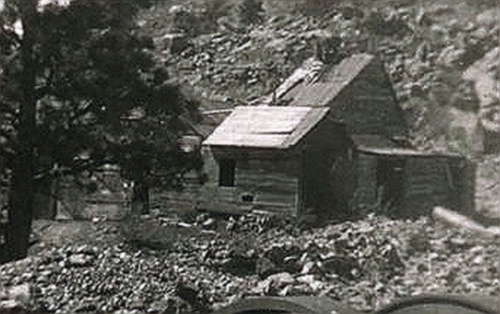
Comstock Mine, undated. Ferguson Archives.
The concept that Hekla might have been the literal Gates to the Nether World
seems to have combined elements of Christian belief with Viking beliefs.
Our word for Purgatory takes its name from the goddess Hel or her place of
residence, Helheim, which rather than being stoked by perpetual fire was
cold and dank and inhabited by those who died other than in battle. Thus,
the concept of Hekla was one which combined the Viking cold with the
Christian heat and rather than being inhabited by sinners was a
place inhabited by non-warriors.
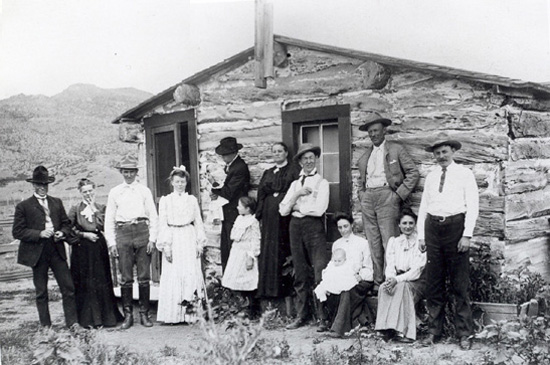
Ferguson Family, July 4, 1905. Ferguson Archives.
The homestead depicted now lies beneath the waves of Granite Springs Reservoir.
But just as in the case of Grand Encampment, by 1908 the age of copper mining came to an
end in the Silver Crown Mining District. Only the Comstock operated by one of the
Ferguson sons would remain in sporatic operation until World War II.
Next page: Hecla continued.
|